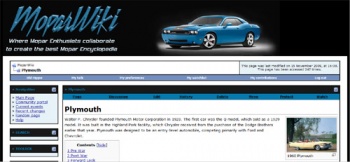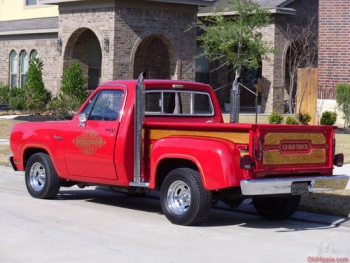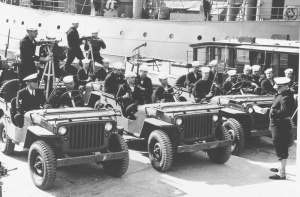Difference between revisions of "Sandbox-B"
| Line 90: | Line 90: | ||
|} | |} | ||
;Diamante | ;Diamante | ||
| − | :<center>[[Image: | + | :<center>[[Image:Lilred-jan11-a.jpg|thumb|350px|1978 Lil Red Express]]</center> |
| − | + | == [[Background:]] == | |
| + | <!-- One or two Paragraphs to skim over the big picture --> | ||
| − | |||
| − | + | The Last American Hot Rod to roll off the assembly line in the late 1970s.78 Lil' Red Truck | |
| − | |||
| − | + | [[Dodge]] released the Lil' Red Express Truck In 1978 it was one of the most unique Dodge trucks that had ever been produced. The Lil' Red Express was not only a real looker but these trucks were also real performers also. In 1978 The Dodge Lil' Red Express was the fastest American made vehicle from 0 to 100 MPH as tested by Car and Driver magazine. | |
| − | + | Because of a loophole in the emissions regulations the 1978 Dodge Lil' Red Express Truck's did not have [[catalytic converters]], what the Lil' Red Express did have was a special High Performance 360 C.I. 4-barrel small block engine code (EH1) which was a modified version of the 360 police engine (E58) producing 225 net horsepower @ 3800 RPM. The package also included [[Hemi]] style mufflers with a crossover pipe breathing through 2 chrome stacks located behind the cab, a special 727 transmission and 3.55:1 rear gearing. | |
| − | + | The 1978 Dodge Lil' Red Express Truck rode on GR60x15 raised white letter tires on 7-inch Chrome wheels up front and LR60x15 on 8-inch chrome wheels on the rear and there was no spare included. All 1978 Dodge Lil' Red Express Truck's were automatics the interiors were available with a standard bench seat in red or black or with optional buckets and a fold down arm/rest console which was available both years. 1978 and some early 1979 Dodge Lil' Red Express Truck's used the "tuff" steering With the success of the 1978 Dodge Lil' Red Express Truck production of the 1979 Dodge Lil' Red Express Truck's was increased to 5,118. Most of the features remained unchanged for 1979 however there was some changes which included a catalytic converter, unleaded gas, 85 MPH speedometer. | |
| − | + | == [[History:]] == | |
| − | + | <!-- Background. If the make or model spans decades, then make each decade (IE:1930-1940) a Level Two Headline. --> | |
| − | |||
| − | + | === [[Model Predecessor]] === | |
| − | + | 1977-78 [[Dodge]] [[Warlock]] Truck | |
| + | === [[Model Successor]] === | ||
| + | |||
| + | 1990-1992 Lil' Red Express Dakota by L.E.R Industries | ||
| + | |||
| + | |||
| + | === [[Export Versions]] === | ||
| + | |||
| + | |||
| + | === [[Related Models]] === | ||
| + | |||
| + | * [[Warlock]] | ||
| + | * [[Midnite Express Truck]] | ||
| + | * [[True Spirit]] | ||
| + | |||
| + | === [[Competition]] === | ||
| + | |||
| + | *Ford F-Series Trucks(For 1978 & 1979) | ||
| + | *Chevrolet Full Size Trucks (For 1978 & 1979) | ||
| + | |||
| + | |||
| + | === [[Body Styles]] === | ||
| + | |||
| + | Regular Cab, Step Side, Short Box Only | ||
| + | |||
| + | == [[Technical:]] == | ||
| + | |||
| + | |||
| + | *Li'l Red Truck Pkg. (YH6) | ||
| + | *Equipment Sales Code 1978 Code Description Sales Code 1979 Code Description | ||
| + | *Bright front bumper MD2 Chrome bumper | ||
| + | *Bright rear bumper MD3 Chrome bumper | ||
| + | *Exterior paint color PY3442 Bright Canyon Red PY3450 Medium Canyon Red | ||
| + | *G.V.W. YW4 6100 pounds YW4 6050 pounds | ||
| + | *360 cubic inch 4BBL V8 EH1 High Performance EH1 High Performance | ||
| + | *Automatic transmission (required) FA3 A-727 | ||
| + | *Loadflight FA0 A-727 | ||
| + | *Oil Gauage LB2 Electric Analog LB2 Electric Analog | ||
| + | *Rear Axle AV2 3.55:1 AV2 3.55:1 | ||
| + | |||
| + | the below is not very clear -- hopefully someone can tighten it up | ||
| + | |||
| + | Prototype versus - production EH-1 Specification | ||
| + | |||
| + | *EH-1, Engine Component A / Block "Prototype Specification" A / Block "Production Specification" | ||
| + | *Carburetion Holley 4160 series 4bbl .....850-CFM ThermoQuad 4bbl | ||
| + | *Intake Manifold Holley Aluminum Hi-Rise Factory Spread boar Hi-Rise | ||
| + | *Cylinder Heads W-2 Hi-Performance E-58 Production | ||
| + | *Air Induction Dual snorkel fresh air sys. Dual snorkel fresh air sys. | ||
| + | *Camshaft Duration 252 degrees w/Overlap 33 degrees Duration 252 degrees w/Overlap 33 degrees | ||
| + | *Oil Pan 5qt. w/windage tray 5qt. Standard | ||
| + | *Exhaust Dual 2 1/2" Dual 2 1/2" | ||
| + | *Mufflers 2 A134-440 Wedge 2 A134-440 Wedge | ||
| + | *Compression Ratio 8.2:1 8.2:1 | ||
| + | *Horsepower 230 net @ 3800 RPM 225 net @ 3800 RPM | ||
| + | *Torque 295 lb/ft @ 3200 RPM 295 lb/ft @ 3200 RPM | ||
| + | *1/4 Mile Performance 14.70 seconds @ 93 MPH 15.71 seconds @ 88 MPH | ||
| + | *Gas Mileage 13.0 MPG 13.1 MPG | ||
| + | *Steering wheel LF4 Tuff Wheel LF6 Four Spoke Western | ||
| + | *Chrome five-slot disc road wheels RA3 | ||
| + | **RA6 Front 15"x7" | ||
| + | **Rear 15"x8" RA6 (5) 15"x8" | ||
| + | *GOOD YEAR Raised white outline letter radial tires WMG F/ WMH R | ||
| + | ** Front GR60x15 | ||
| + | ** Rear LR60x15 | ||
| + | |||
| + | Also included as standard equipment on the Li'l Red Truck. | ||
| + | *Dual exhaust with vertical stack-pipes | ||
| + | *Chrome exhaust tips and stainless heat shields | ||
| + | *Chrome plated valve covers | ||
| + | *Chrome-plated air-cleaner cover | ||
| + | *Chrome-plated side bed steps | ||
| + | *Utiline body side and tailgate oak body trim panels with chrome-headed prop nuts | ||
| + | *Gold 3M pinstriping tape decals on tailgate and doors. | ||
| + | |||
| + | |||
| + | === [[Engines]] === | ||
| + | EH1 360 High Performance Chrysler LA small block based on the car division E58 police engine with upgrades. The upgrades included a 68 340 Chrysler LA small block camshaft with a 276 duration, .484 lift and 48 degree overlap. Then a double roller timing chain and gear set was added for durability. A set of 360 high flow heads featuring 1.88/1.62 valves helped moves gases in and out. It used a forged crankshaft with 8:4:1 flat top pistons and featured a bore of 4.00 inches and a stroke of 3.58 inches respectively. It is also believed the rocker arms and springs are more heavy duty than the standard E58 pieces used. Also, Chrysler topped the package by using a 850 cfm Carter Thermoquad 4bbl carburetor with bigger primaries and secondaries than the police version of the carburetor. The engine was rated at 225 hp @ 3800 RPM and 295 lb/ft of torque at 3200 RPM. | ||
| + | |||
| + | Note: The prototype Lil' Red Express used W2 Cast Iron Heads, Holley Aluminum Intake, and Holley 4160 4bbl carburetor. Again, this was only the prototype and not the production version that featured this items like some people believe. | ||
| + | |||
| + | === [[Transmissions]] === | ||
| + | A727 Loadflite Transmission with upgrades. The upgrades included a 440 valve body install to provide firmer and positive shifts. A Chrysler 9" 2500 rpm stall torque converter was used to give quicker launches and acceleration. The gear ratios were as follows: 1st= 2.45; 2nd= 1.45; 3rd= 1.00; and reverse is a 2.20 ratio. | ||
| + | |||
| + | == [[Specifications:]] == | ||
| + | <!-- Wheelbase, overall length, weight, capacities, etc. --> | ||
| + | |||
| + | |||
| + | === [[Length]], [[width]], [[height]], [[wheelbase]] === | ||
| + | |||
| + | *Wheelbase = 131.0" | ||
| + | *Overall length= 210.2" | ||
| + | *Overall width= 79.5" | ||
| + | *Curb Weight= 3815 pounds | ||
| + | *Fuel Capacity= 20.0 gallons | ||
| + | *Tread Front/Rear= 67.5"/65.2" | ||
Revision as of 18:43, 11 August 2012
this is one of the three sandboxes where would be collaborators can play around with their formatting until it looks right -- and then add it to the article they want to improve. Newbies are really encouraged to use one of the sandboxes to play around in (below this text), and delete when finished they other sandboxes are Sandbox-A & Sandbox-C. Delete your text when finished, and use another sandbox if there is text in this one.
|
|
|
|
Background:The Last American Hot Rod to roll off the assembly line in the late 1970s.78 Lil' Red Truck
Because of a loophole in the emissions regulations the 1978 Dodge Lil' Red Express Truck's did not have catalytic converters, what the Lil' Red Express did have was a special High Performance 360 C.I. 4-barrel small block engine code (EH1) which was a modified version of the 360 police engine (E58) producing 225 net horsepower @ 3800 RPM. The package also included Hemi style mufflers with a crossover pipe breathing through 2 chrome stacks located behind the cab, a special 727 transmission and 3.55:1 rear gearing. The 1978 Dodge Lil' Red Express Truck rode on GR60x15 raised white letter tires on 7-inch Chrome wheels up front and LR60x15 on 8-inch chrome wheels on the rear and there was no spare included. All 1978 Dodge Lil' Red Express Truck's were automatics the interiors were available with a standard bench seat in red or black or with optional buckets and a fold down arm/rest console which was available both years. 1978 and some early 1979 Dodge Lil' Red Express Truck's used the "tuff" steering With the success of the 1978 Dodge Lil' Red Express Truck production of the 1979 Dodge Lil' Red Express Truck's was increased to 5,118. Most of the features remained unchanged for 1979 however there was some changes which included a catalytic converter, unleaded gas, 85 MPH speedometer. History:Model PredecessorModel Successor1990-1992 Lil' Red Express Dakota by L.E.R Industries
Export VersionsRelated ModelsCompetition
Body StylesRegular Cab, Step Side, Short Box Only Technical:
the below is not very clear -- hopefully someone can tighten it up Prototype versus - production EH-1 Specification
Also included as standard equipment on the Li'l Red Truck.
EnginesEH1 360 High Performance Chrysler LA small block based on the car division E58 police engine with upgrades. The upgrades included a 68 340 Chrysler LA small block camshaft with a 276 duration, .484 lift and 48 degree overlap. Then a double roller timing chain and gear set was added for durability. A set of 360 high flow heads featuring 1.88/1.62 valves helped moves gases in and out. It used a forged crankshaft with 8:4:1 flat top pistons and featured a bore of 4.00 inches and a stroke of 3.58 inches respectively. It is also believed the rocker arms and springs are more heavy duty than the standard E58 pieces used. Also, Chrysler topped the package by using a 850 cfm Carter Thermoquad 4bbl carburetor with bigger primaries and secondaries than the police version of the carburetor. The engine was rated at 225 hp @ 3800 RPM and 295 lb/ft of torque at 3200 RPM. Note: The prototype Lil' Red Express used W2 Cast Iron Heads, Holley Aluminum Intake, and Holley 4160 4bbl carburetor. Again, this was only the prototype and not the production version that featured this items like some people believe. TransmissionsA727 Loadflite Transmission with upgrades. The upgrades included a 440 valve body install to provide firmer and positive shifts. A Chrysler 9" 2500 rpm stall torque converter was used to give quicker launches and acceleration. The gear ratios were as follows: 1st= 2.45; 2nd= 1.45; 3rd= 1.00; and reverse is a 2.20 ratio. Specifications:Length, width, height, wheelbase
More |
History World War I started the age of mechanization of the US Army. The Army bought many vehicles from many vendors to move men and materials from location to location. By the middle 1930’s the Army realized the logistical nightmare causing maintenance and supply issues caused by having so many vendors and vehicle types. The desire to standardize on a smaller group of vehicles led to the search for smaller, faster easier to maintain vehicle. The army tested several vehicle concepts over the years, including a vehicle dubbed the “Belly-Flopper”. The “Belly-Flopper” was designed much like a cross between a kid’s sled and a go-cart. The driver and a passenger lay on their stomachs to drive the vehicle, unseen by the enemy. The specifications for 70 units of a test vehicle were sent out on July 7, 1940, called for:
Only three companies, of 135 invited to bid, responded to the contest, Ford Motor Company, Willys-Overland (pronounced Willis-Overland), and American Bantam Car Company and of these, the Bantam Car Company was the most aggressive. They had their blueprints of their vehicle into Washington in 5 days. Bantam delivered a prototype by the September 23, 1940 deadline. With war breaking out in Europe, both Ford and Willys were allowed to submit vehicles for testing. Both of these competitors were also given access to the Bantam plans, explaining the look-alike similarities of the three prototypes. The Army ordered a total of 1500 of each vehicle for further testing and early 1941 saw these vehicles entered into Army inventory. Willys and Ford received the contracts to actually build the vehicles based on Bantam’s designs, as Bantam didn’t have suitable manufacturing facilities. Bantam did get the contract to build the trailers need for the vehicles. Both the Willys and Ford parts were interchangeable. The name Jeep is said to derive from several sources. Some say the name came from the GP (General Purpose) designation, others say it came from the cartoon character “Eugene, the Magical Jeep” from the Popeye cartoons. Eugene had the ability to go anywhere (by magic of course), as did the Willys vehicle. The Jeep became the vehicle of choice for the Army and it was said that the little vehicle could move faster than a tank and go places that tanks couldn’t go. The Jeep (both the Willys MB and Ford GPW) proved to be a reliable, well made vehicle, impressing soldiers who both drove and maintained the vehicles. It was said at the time that Jeep won the war.
After the War, as soldier were returning home, many wanted a Jeep of their own. Willys, seeing a demand for the Jeep trademarked the name, for its line of vehicles based on the venerable vehicle. The Jeep CJ-2A (Civilian Jeep 2A) was introduced in late 1945, and was mechanically identical to the MB that was produced for the Army, but with a few differences, such as chrome trim and larger headlamps. The fuel tank intake was on the left side panel, and the spare tire was moved to the rear tailgate. The rear panel also became a flip down tailgate. The first year saw only 1,824 units made, but the end of production in 1949 produced a total of nearly 137,000 units. More |
|
|
|
|


